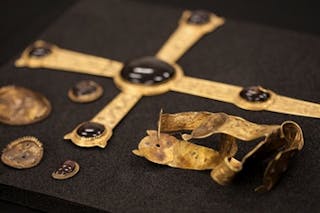Crafting replicas of the Staffordshire Hoard

Researchers
Gay Penfold (Centre Manager), Samantha Chilton (Finishing Technologies Specialist), Frank Cooper (Technical Manager), Keith Adcock (CAD/CAM Technologist) and Mark Watkins (CAD/CAM Technologist) - all Jewellery Industry Innovation Centre (JIIC). Pieta Greaves (Conservation co-ordinator of the Staffordshire Hoard) and Dave Symons (Curator of the Staffordshire Hoard) were also involved in the project.
Background
The Staffordshire Hoard is one of the world's largest collections of Anglo-Saxon gold and was originally found in a field near the village of Hammerwich in Staffordshire. The complete hoard includes over 3,500 items at an estimated value of £3.2 million, and is jointly owned by The Potteries Museum and Art Gallery and Birmingham Museum and Art Gallery.
The team at the Jewellery Industry Innovation Centre (JIIC) at the School of Jewellery have been working with these artefacts to create replicas for use in museums.
The research and progress
The JIIC team are using their laser scanning equipment to digitally capture data at an incredible level of accuracy. Each scan is accurate to a scale five microns, or 0.005 millimetres. The scans are then used to create replicas for display cases and for museum visitors to handle and get closer to the Hoard than ever before.
The replicas are used in the new gallery at the Birmingham Museum and Art Gallery, which opened in October 2014.
The project team continue to create replicas, however funding is required to recreate sixteen of the most dramatic objects in the Hoard. To donate to the project, please visit the BMAG website or call +44 (0)121 348 8293.
Watch the videos below to find out more about the project.
About the Staffordshire Hoard
Creating the replicas
The team at the Jewellery Industry Innovation Centre (JIIC) have been working with these artefacts to create replicas for use in museums.